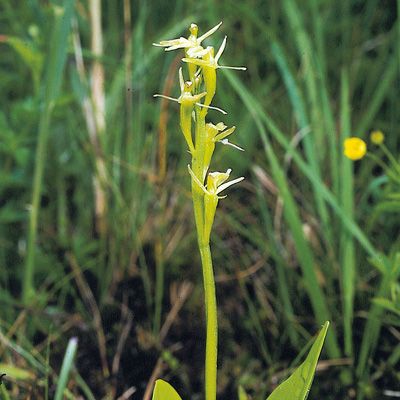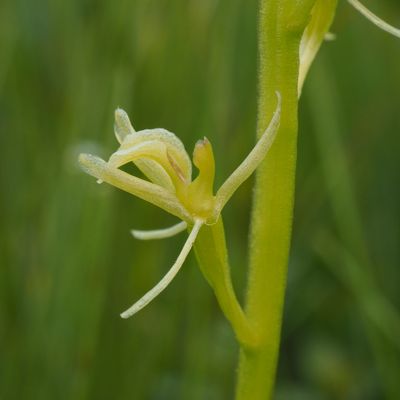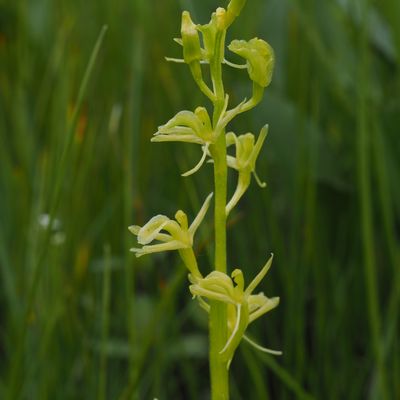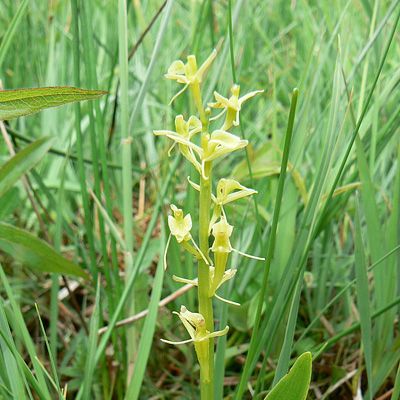Liparis loeselii (L.) Rich.
1027180
Species
ISFS : 241800
Checklist : 1027180
ISFS : 241800
Checklist : 1027180
Contains :
Synthesis
Species description (© Flora Helvetica 2018)
10-20 cm hoch, am Grund mit 1-3 lanzettlichen, 4-10 cm langen Blättern. Blütenstand 3-8(-18)blütig. Blüten gelbgrün. Perigonblätter 4-5 mm lang, abstehend, mit nach aussen gerollten Rändern, daher sehr schmal erscheinend. Lippe etwa so lang wie die Perigonblätter, oval, rinnig gefaltet, abwärts gebogen. Säule (Griffel + Staubblatt) frei stehend, nicht wie bei den meisten Orchidaceae durch die Perigonblätter verdeckt.Flowering period (© Flora Helvetica 2018)
6Habitat and distribution inside Switzerland (© Flora Helvetica 2018)
Kalkhaltige Flachmoore / kollin-montan / M (besonders MZ und ME), vereinzelt AWorld distribution (© Flora Helvetica 2018)
Eurosibirisch-nordamerikanischEcological indicator (© Landolt & al. 2010)
4+w41-442.g.2n=26,32Status
IUCN status
VulnerableNational Priority
4 - weak national priorityInternational responsibility
1 - weakConservation
Threats
Entwässerung
Eutrophierung
Aufgabe der traditionellen Streuenutzung
Verbuschung und Verschilfung der Standorte
Beweidung
Mechanische Einwirkungen durch Freizeitaktivitäten (z. B. Tritt, Photographieren)
Kleine, isolierte Populationen
Distribution map
Habitat and distribution inside Switzerland
M (besonders MZ und ME), vereinzelt AWorld distribution
Eurosibirisch-nordamerikanischEcology
Life form
Geophyte
Habitats
Milieux Phytosuisse (© Prunier et al. 2017)
Habitats © Delarze & al. 2015
 | 2.2.3 - Kalkreiches Kleinseggenried (Davallseggenried) (Caricion davallianae) |
bold
Dominant species, influencing the appearance of the habitat
 Character species
Character species
 Less strictly linked to a specific habitat
Less strictly linked to a specific habitat
Ecological indicator values by © Landolt & al. (2010)
| Soil factors | Climatic factors | Salinity tolerance | |||
|---|---|---|---|---|---|
| Humidity Value H | 4+w | Light Value L | 4 | Salinity Index | -- |
| Reaction Value R | 4 | Temperature factor T | 4 | ||
| Nutriments value N | 1 | Continentality K | 2 | ||
- Ecological values legend
Humidity Value H 1 very dry 1+ dry 2 moderatly dry 2+ moist 3 medium wet 3+ wet 4 very wet 4+ soggy 5 submerged or underwater f plants living in running water u mostly submerged plants v partly submerged, partly floating plants w humidity moderately variable (± scale of 1-2) w+ highly variable humidity (scale exceeding ± 2) Reaction Value R 1 Very acid (pH 2.5-5.5) 2 acid (pH 3.5-6.5) 3 lightly acid to neutral (pH 4.5-7.5) 4 neutral to basic (pH 5.5-8.5) 5 basic (pH 6-5 -> 8.5 Nutriments value N 1 very low in nutrients 2 low in nutriments 3 medium-poor to medium-rich in nutrients 4 rich in nutriments 5 very rich in nutriments Salinity tolerance 1 halotolerant 3 halophyle Light Value L 1 very shady 2 shady 3 lighted areas 4 luminous 5 highly luminous Temperature factor T 1 alpine to nival stages (from the treeline to the snowline) 1+ suprasubalpine and upper subalpine levels (pine and larch forests) 2 subalpine level (coniferous forests without beeches up to the upper limit of spruces) 2+ lower subalpine and upper mountain stages 3 mountain level (beech and silver fir forests, in the central Alps Scots pine forests) 3+ lower mountain and upper hill levels 4 hill level (mixed deciduous oak forests) 4+ hot places, hill level 5 very hot places, hill level (only in the hottest places, typical of southern Europe) Continentality K 1 Atlantic (high air humidity, very low temperature variations, mild winters) 2 Sub-Atlantic (high air humidity, low temperature variations, relatively mild winters) 3 sub-Atlantic to subcontinental (average air humidity, moderately variable temperature, slightly low winter temperatures) 4 subcontinental (low air humidity, large temperature variations, rather cold winters) 5 continental (very low air humidity, very large temperature variations, cold winters)
Water dependency
| Rivers | 0 - No link |
| Calm water | 1 - Secondary habitat |
| Ground water | 0 - No link |
Nomenclature
Accepted Name (Checklist 2017)
Liparis loeselii (L.) Rich.
Vernacular name
Deutscher Name :
Zwiebelorchis, GlanzkrautNom français :
Liparis de LoeselNome italiano :
LiparideMatch with other reference books
| Relation | Nom | Book | No |
|---|---|---|---|
| = | Liparis loeselii (L.) Rich. | Checklist 2017 | 241800 |
| = | Liparis loeselii (L.) Rich. | Flora Helvetica 2001 | 3000 |
| = | Liparis loeselii (L.) Rich. | Flora Helvetica 2012 | 2586 |
| = | Liparis loeselii (L.) Rich. | Flora Helvetica 2018 | 2586 |
| = | Liparis loeselii (L.) Rich. | Index synonymique 1996 | 241800 |
| = | Liparis loeselii (L.) Rich. | Landolt 1977 | 744 |
| = | Liparis loeselii (L.) Rich. | Landolt 1991 | 651 |
| = | Liparis loeselii (L.) Rich. | SISF/ISFS 2 | 241800 |
| = | Liparis loeselii (L.) Rich. | Welten & Sutter 1982 | 2570 |
= The taxon corresponds to the accepted taxon (Checklist 2017)
< The taxon is included in the accepted taxon (Checklist 2017)
> The taxon includes (among others) also the accepted taxon (Checklist 2017)
< The taxon is included in the accepted taxon (Checklist 2017)
> The taxon includes (among others) also the accepted taxon (Checklist 2017)
Status
Native status
-IUCN list of endangered species (© Walter & Gillett 1997) : No
Status on national Red List 2016
IUCN status:
Vulnerable

Additional information
IUCN criteria: C1; C2a(i)
Status on regional Red List 2019
| Biogregraphic regions | Status | IUCN criteria |
|---|---|---|
| Jura (JU) | VU | C1; C2a(i) |
| Mittelland (MP) | VU | C1; C2a(i) |
| Alpennordflanke (NA) | EN | C1; C2a(i) |
| Alpensüdflanke (SA) | CR | C2a(ii); D |
| Östliche Zentralalpen (EA) | CR | C2a(ii); D |
| Westliche Zentralalpen (WA) | RE |
- Legend
EX Extinct RE Regionally Extinct CR(PE) Critically Endangered, Probably Extinct CR Critically Endangered EN Endangered VU Vulnerable NT Near Threatened LC Least Concern DD Data Deficient NE Not Evaluated NA Not Applicable
National Priority Species List Status
| National Priority | 4 - weak national priority |
| Need to take action | 1 - |
| International responsibility | 1 - weak |
| Need to monitor populations | 2 - |
Protection status
| International (Bern Convention) | Yes | |
| AG | total protection | (01.01.2010) |
| AI | total protection | (13.03.1989) |
| BE | total protection | (01.01.2016) |
| FR | total protection | (12.03.1973) |
| GE | total protection | (25.07.2007) |
| GL | total protection | (07.05.2006) |
| GR | total protection | (01.12.2012) |
| Switzerland | total protection | |
| OW | total protection | (01.04.2013) |
| SO | partial protection | (23.02.1972) |
| VD | total protection | (02.03.2005) |
| ZG | total protection | (01.10.2013) |
| ZH | total protection | (03.12.1964) |
| TI | total protection | (23.01.2013) |
- Disclaimer
InfoFlora compiles information on protected species as accurately as possible, taking it from the respective cantonal laws. In some cases, however, it was not possible to use the plant names as listed in the original text, but an interpretation of their taxonomy or nomenclature was necessary. The exact meaning of the categories „completely protected“ and „partially protected“ differs among the cantons.
InfoFlora cannot guarantee that the information on the protection status is correct and complete. In case of doubts, we recommend to look up the texts of the respective cantonal law.
Status by sector of activity
| Agriculture-related environmental objectives : | more informations | |
| Forest management environmental objectives : | more informations |
Conservation
Threats and measures
Entwässerung
Keine neuen Entwässerungen
Regulierung des Wasserhaushalts zugunsten der Art
Eutrophierung
Düngeverbot in der nahen Umgebung
grosse Pufferzonen
Aufgabe der traditionellen Streuenutzung
Anreiz geben zur Weiterführung einer extensiven Nutzung (Ökobeiträge)
ansonsten simulieren der ehemaligen Streuenutzung als Pflegenutzung (von Hand oder mit leichtem Gerät über gefrorenem Boden im Winter)
Verbuschung und Verschilfung der Standorte
Regelmässige Mahd ab Ende September, ca. alle 2-3 Jahre sogar erst im folgenden März mähen (Fruchtreife erst im Februar!)
Abtransport des Schnittguts
Beweidung
Keine Beweidung (Ausnahme: extensive Beweidung mit alten Rassen im Rahmen eines Pflegekonzepts)
Mechanische Einwirkungen durch Freizeitaktivitäten (z. B. Tritt, Photographieren)
Lenkung der Ausflügler im Problembereich
Sperrung von Wegen
Naturlehrpfade (Prügelpfad) einrichten
Kleine, isolierte Populationen
Schutz (Mikroreservate)
regelmässige Bestandeskontrolle aller Populationen
populationsbiologische Untersuchungen durchführen
Dauerflächen-Beobachtung
Erfolgskontrolle der Massnahmen gewährleisten





